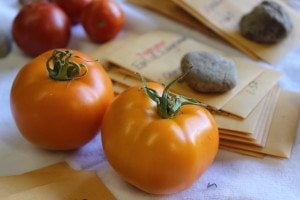Happy summer (officially), Grow Appalachia family! Holly, VISTA at Grow App HQ here, finding it sort of hard to believe that in just about nine weeks, I will be finished with my VISTA term of service. What is that they say- “time flies when you’re having fun?” Among many other things, it’s definitely been fun!
We’re talking about heirloom seeds for the blog this week, something that many of you are no doubt familiar with. For those of you that aren’t, we’ll start right at the beginning. An heirloom seed is a seed, or seeds, that have been handed down from one generation to another, concentrated in a particular region. These seeds are selected for a specific trait they carry, and this practice, called seed-saving, helps to preserve these traits that are otherwise not saved. Heirlooms are also open-pollinated, which means they are pollinated by wind or insect, without any human aid or intervention; THAT could result in some entertaining combinations. And finally, gardeners often grow heirloom varieties because they argue that they taste better than other varieties (Source here). As someone who loves tomatoes, I can definitely vouch for this; having attended a seed exchange last fall and having sampled many different kinds of tomatoes there, they were, hands down, better-tasting than any other tomato I’ve tried! All right, I need to move on…tempted to go sneak into someone’s garden and pluck one off for myself…
While the general consensus is that heirlooms are more desirable, sometimes, it’s not always “what you see is what you get”. Some heirloom varieties require very specific growing conditions, which you may not find in your backyard garden. You may have inconsistent germination, or none at all, if it’s an older seed, or a seed that wasn’t stored properly. Others are vulnerable to diseases and other pests that were unknown to earlier generations of gardeners, and nowadays you may have to select more resistant cultivars than what was grown in your family. As with any type of veggie you grow, it’s always a bit of trial-and-error, so try planting a row of heirloom seeds, or maybe just half a row if you’re not quite feeling so daring, and see what happens!
Here’s an article with some background on heirlooms and some varieties that you can grow.
What’s in a name?
If you’ve ever purchased heirloom seeds, or if you perhaps have some on hand, you might notice that some of them have rather odd names. Warted Hubbard squash. Arkansas traveler tomato. Greasy beans. Country Gentleman corn. Drunken woman frizzy-headed lettuce (Yes, it’s real). Where do they get their funny names? Believe it or not, heirloom vegetables’ stories often contain a colorful history that’s associated with their given name. For example, Hubbard squash originated in the western world, where seeds eventually found their way to Ms. Elizabeth Hubbard, who grew it and was smitten by its flavor. She shared the seeds with her neighbors and friends and it was eventually named after her in 1909. Here you can read more about the Hubbard squash, and several other common types of heirlooms and their names. Who knows? Maybe in the next few decades, you or your family can come up with your own. I’m thinking “Yoda’s Delight” for asparagus (Yoda’s my cat and she loves the stuff).
Further Reading
If you subscribe to our newsletters, you may remember waaayyy back in October of last year, we featured some heirloom stories from the seed exchange we had recently attended. I read back through it for research purposes and came across some great resources, which are posted below.
Southern Exposure Seed Exchange is a seed website that not only offers thousands of heirloom varieties, they’ve also given donations of seeds to many of our partner sites!
Basic Seed Saving, a 48 page book written by Bill McDorman
A blogging favorite of ours, Mother of a Hubbard (Cathy Rehmeyer, who, fun fact, is also on the Berea College Appalachian Fund advisory board), wrote a great blog post on seed-saving.
Sustainable Mountain Agriculture Center, Inc, Bill Best’s heirloom seed operation. Bill Best is probably THE heirloom bean/tomato guru of Appalachia. (Ok, we might be a little bit biased because he does live in Berea).
Do you have any crazy heirloom stories from your family? We’d love to hear them! Until next time, happy growing, heirlooming, and sharing!
One last thing: Grow Appalachia is in the running for a $15,000 grant from Nature’s Path Organic Foods. The grant funding will go to support farmer’s market-related infrastructure. Having said all of that, WE NEED YOUR HELP!!! We need VOTES! Voting is open between now and July 6th, and you can vote as many times as possible! Please, please, share and vote if you feel so inclined, and thank you for your support! Voting link here!






Leave A Comment